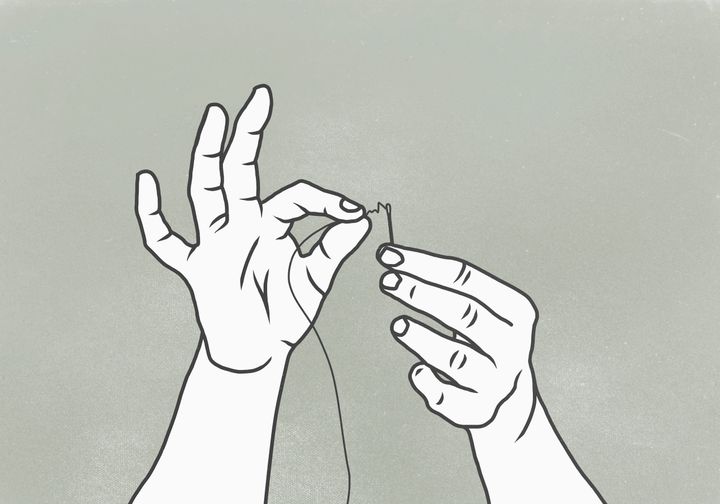When something breaks, it’s often a lot easier (and far less fuss) to throw it in the bin and quickly order a new one online with the click of a button. But this is not only wasteful, it’s also impacting the planet – and in turn, us.
A survey by the British Heart Foundation (BHF) found just under a third of people (30%) have thrown away furniture, electrical items and homewares in good enough condition that they could have been re-used, sold or donated. And one in five (19%) admitted they wouldn’t know how to donate or recycle furniture and homeware.
But why is the focus always on how we can get rid of stuff? What about rolling up our sleeves and just fixing it? To mark International Repair Day (October 17), we’ll walk you through how to do some basic repairs at home.

Mending a hole in your t-shirt
We’ve all been there: you’ve discovered a small hole in the middle of your t-shirt and you don’t know whether to bin it or resign it to the ‘bed t-shirt’ drawer. The answer is neither. You can repair that hole and give your top a new lease of life.
Professor Pincushion, who shares sewing tutorials on YouTube, has a brilliant no-sew option. This tip works best for small holes – we’re talking 5mm or less.
Grab your t-shirt, turn it inside out and briefly iron the area where the hole is. Then, start pushing the material together. Next, grab a patch of bonding web and on top of that, place a slightly larger patch of stabiliser. If you don’t want glue getting onto your ironing board, pop a bit of baking paper underneath.
Now, put a cloth or tea towel over your t-shirt, spray it with some water, stick your iron on the wool setting, and then place your iron on top of where the patches are for about 10 seconds. Flip the t-shirt over to the right side (so it’s no longer inside out) and start pushing the fabric together, then press it briefly with the iron just to help it all bind together. Et voilà! A fixed tee.
Speeding up your laptop
While we don’t see it (out of sight, out of mind), our electronic waste is being sent to landfill. The UN’s Global E-waste Monitor revealed 53.6 million metric tonnes of electronic waste was generated globally in 2019, up 21% in 5 years.
At a time when everything is already pretty bleak, destroying the planet one trashed laptop at a time is not where we want to be headed. When your laptop starts making a deafening whirring sound and you get the spinning wheel of doom (Macbook owners know), your first thought might be to get a new one. Instead, try to fix it before you get rid – and even then, you should recycle it. Currys PC World will recycle your old electronics if your local council doesn’t offer such a service.
The Restart Project, a social enterprise that aims to fix our (rather dysfunctional) relationship with electronics, shares some quick and easy tips for speeding up your laptop, that don’t involve replacing a hard drive.
First: check what’s using up your laptop’s resources. Is it running 10+ programmes in the background? Yes? Well, no wonder it’s slow. Close some of them and see whether that helps. The next tip is to delete any programmes or apps you don’t use that are taking up space. Look for things like old software or packages that came with your computer that you’ve never used. If you have a few types of anti-virus software downloaded on there, stick to one and delete the others, as these can take up a lot of processing power.
And the final tip is clearing hard drive space. According to the Restart Project, you should keep 15% of your hard drive empty all the time. You can clear hard drive space by uninstalling programmes, clearing out your downloads folder and deleting other bulky files – like video and media files – you no longer use.
Sorting your dodgy toaster
Janet Gunter is outreach lead and co-founder of The Restart Project. She tells HuffPost UK kitchen appliances like toasters and blenders are often in need of repair. But they can be tricky to do – and require a fair bit of caution.
Toaster not working? Unplug it, firstly. Gunter says a lot of repairs with toasters are often cleaning-related. “Before you assume it’s game over, clean it,” she says, as often you can get stuff wedged in there which can cause issues.
There are other issues that can go wrong with toasters that are harder to deal with – for example, if the heating element goes. If that does happen, you should try to take it to a repair shop to get it looked at before you take it to be recycled.
The Restart Project runs a Wiki site with tips and tricks for mending, as well as forums to confer with other ‘fixers’ – and there’s a page on fixing toasters.
Finding a local ‘repair hero’
In the UK, there are still community repair opportunities if you can’t find a commercial repair shop or afford it, says Gunter. She recommends taking your items to repair cafes, bike workshops, or even community mending groups.
There are also local commercial repair shops dotted across the UK. “A lot of people think they no longer exist, but they definitely do,” she says. And they need people’s support, now more than ever. You can find a local repair shop on the Restart Project’s Repair Directory – or suggest a shop near you.
Our new video series, Wear and Care, shows you how to turn your trash into treasure. Save money and waste with how-to videos on repairing or repurposing clothes or home-goods.

